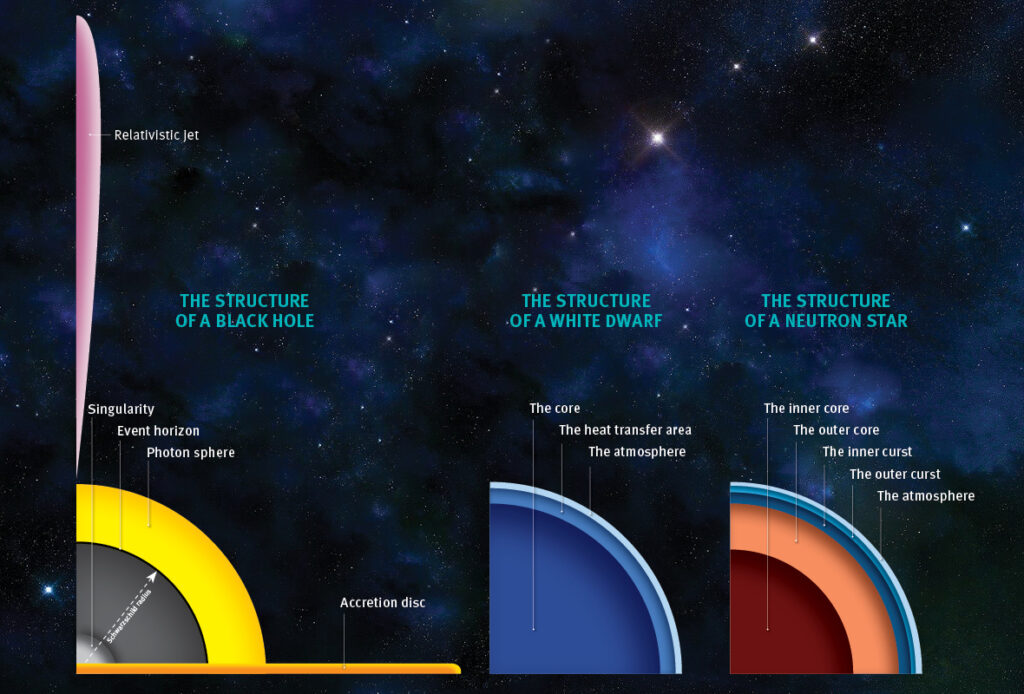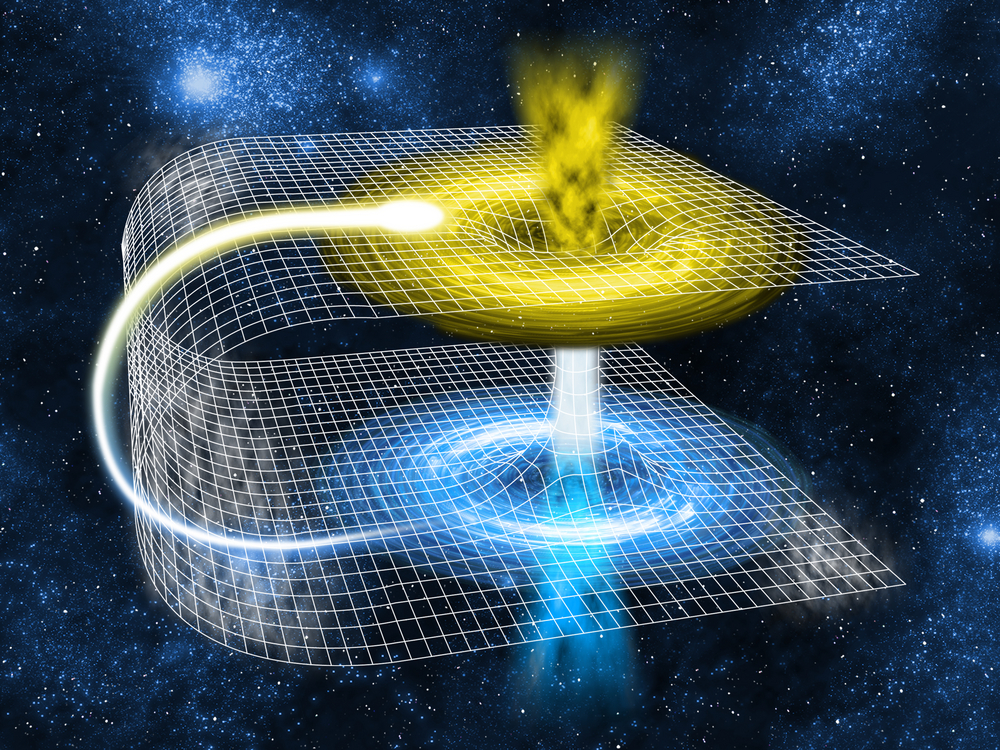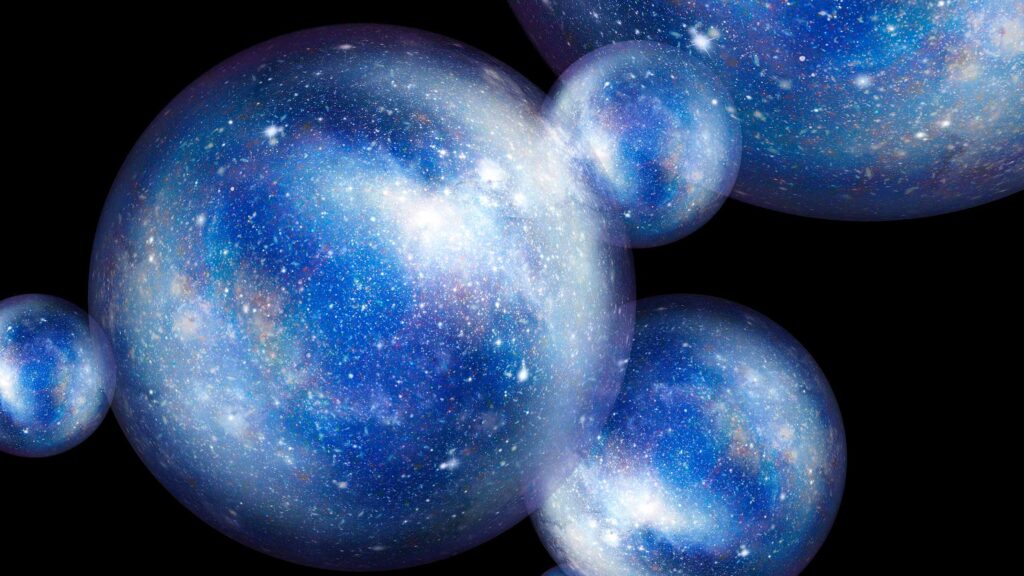Science will never be a finished book.
Albert Einstein
Humanity has already crossed the threshold of the third millennium. Scientific progress has made possible what 100 years ago seemed like an unrealistic dream, a fantasy. But there are still no clear answers to the main questions that were pondered by ancient philosophers: how is our world organized and who are we in it? Looking into the sky, we try to solve the great mysteries of the universe — just like primitive people did.

Today, science knows that the life span of any star is determined by its mass. At the first stage of development, when it is formed from a gas cloud, the temperature in the stellar core rises to several million degrees. Then the reaction of converting hydrogen into helium begins. While the hydrogen is burning, the star is in the main stage of its life, which encompasses about 90% of its existence. This period is called the main sequence. When the hydrogen inside the star runs out, it moves to the next stage, where its further fate depends only on the mass. In small objects like our Sun, the core heats up to a temperature of about 100 million degrees Celsius, after which the helium begins to turn into carbon and oxygen. In this case, the shell inflates so much that a red giant is born as a result.
This stage passes ten times faster than the hydrogen burning stage and takes about 10% of the entire active life time of the star. After burning out the helium, the super-dense core turns into a white dwarf, and the outer shell expands and is dispersed into space. But due to the lack of gravity, low-mass stars are unable to heat up their central region, and carbon and oxygen cannot continue thermonuclear “burning”. However, in stars whose mass exceeds the Sun’s by more than 10 times, the temperature reaches several billion degrees, and a reaction begins with the formation of neon, magnesium and heavier elements — up to iron. As a result, an iron core forms in the center, which grows until the object loses its stability and gravity compresses it even more. It contracts, turning into either a neutron star with a mass of up to a billion tons per 1 cm3, or a black hole with a mass that tends to infinity. Black holes are among the most amazing and mysterious objects in space.

A black hole is a region of space-time whose gravitational attraction is so great that even objects moving at the speed of light, including quanta of light itself, cannot leave it. The boundary of this region is called the event horizon, and its characteristic size is the gravitational radius. After its formation, the black hole immediately begins to absorb the dying luminary, the remnant of which begins to rotate around it, forming an accretion disk that exists for a very short time. However, it is not able to immediately absorb such a large amount of matter, so it throws some of it back at a speed close to the speed of light. At the same time, two directed streams of gamma radiation burst out of the black hole, breaking through the outer layer of the star and being ejected into space. This is a very powerful flow of gamma rays, the brightness of which cannot be compared with anything in the universe. A typical supernova explosion releases as much energy as the Sun releases in its 10 billion years of life, and emits gamma rays 100 million times brighter than a supernova.
Therefore, hypernovae during the explosion at the end of their life form black holes — this is the biggest mystery of the cosmos today. So what is hidden inside this system unfamiliar to physics?
A black hole is neither a solid nor a gaseous entity, being not only a spatial unit. It is an object that distorts both the three dimensions we understand (length, width, height) and the timeline. Scientists believe that in the area inside the event horizon, time acquires a spatial quality being able to move both forward and backward. Space-time is highly distorted due to immense gravity. Light quanta entering a black hole do not simply disappear — their mass is multiplied by the mass of the singularity, which makes it even larger and increases its gravitational forces. The basis for the formation of points of no return is gravity, the magnitude of which is millions of times greater than the Earth’s.
German scientist Karl Schwarzschild explained to the world what a black hole is. According to him, it can be formed at any point in space when a material object having a spherical shape somehow reaches the so-called gravitational radius. The laws of physics and geometry work on Earth, but they do not work on the event horizon. That is why, from a mathematical point of view, it is impossible to calculate the internal components of a black hole.
Let’s contemplate what a singularity is, what it can consist of, and what substance or matter turns into in a black hole. If we solve this riddle, we will be able to find out what the singularity of the universe was before the Big Bang.

In the case of small stars and supernovae, everything seems to be clear: after the explosion, the matter of the star or its nucleus loses the intra-atomic space and the matter is compacted due to gravity to the state known to science as a white dwarf or a neutron star. As for hypernova explosions and the formation of black holes after that, everything is different here. Let’s turn to the famous formula derived by Einstein at the beginning of the last century: E=mc2, where E is energy, m is mass, and c is the speed of light. The mass can also be derived from this formula: m=E/c2. Equivalence of mass and energy is a physical concept of the Theory of Relativity, according to which the total energy of a physical object is equal to its mass multiplied by the factor of the square of the speed of light in a vacuum. From here we conclude that energy and mass are different forms of the same phenomenon. Matter and energy can transform into each other. From the point of view of physics, it makes no sense to separate them. Energy manifests itself as mass — it has inertia and gravitational pull. For example, there is a proton consisting of three quarks, and their total mass (12 MeV) is much smaller than the mass of the proton itself (939 MeV). Even the masses of particles are measured in energy units — electron volts — and they are converted into normal units using the aforementioned formula E=mc2. Studies confirm that when an electron and a positron come together, they annihilate, that is, they disappear. At the same time, two gamma rays are emitted, which again confirms the conversion of mass into energy. Therefore, matter and energy are equivalent. During such a transformation, the property of gravity and the distortion of space-time, inherent in matter transformed into energy, is preserved.

By the way, such a transformation is partially embodied in an atomic bomb, where particles of matter are destroyed, releasing a huge amount of energy. During the nuclear fission reaction of atoms of heavy elements (for example, uranium), the total mass of the “fragments” formed is less than the mass of the nucleus that has split. Therefore, part of its mass is transformed into energy, which we call atomic.
The transformation of matter into energy can be observed by lighting a match. During its burning, energy is also released from the loss of mass, but it is insignificant compared to the nuclear decay reaction. Fire is the result of a chemical reaction of combustion. As in a nuclear reaction, during it, the sum of the masses of the reaction products is less than the initial mass of the fuel and oxidizer (the latter is most often represented by air oxygen). The difference between the initial and final masses is transformed into the kinetic (thermal) energy of the reaction products, which, together with carbon particles heated to high temperatures, create a flame, emitting light visible to the eye. In the fire of chemical reactions, the same Einsteinian transformation of mass into energy takes place, as, for example, in stars. In addition, light itself, as energy, is born in the bowels of matter during a thermonuclear reaction in the cores of stars.
You can observe the transformation of energy into matter using the example of your own body. Let’s start with the fundamental principles.
The basis of biological life on Earth is photosynthesis — a complex chemical process of converting light energy into the energy of chemical bonds of organic substances with the participation of photosynthetic pigments. In modern plant physiology, photosynthesis is most often understood as a photoautotrophic function — a set of processes of absorption, transformation, and use of the energy of light quanta in various endergonic reactions. That is, the energy of light quanta is transformed into an organic substance that is consumed by the animal world, in particular, after its conversion into meat products. As a result of food processing by the body, matter becomes energy necessary for human life, and calories provide nutrition for cells and organs. So, carbohydrates are broken down into glucose, which meets the energy needs of the human body. The excess of this compound is stored in the form of glycogen. In general, the caloric value or energy value of food is understood as the amount of energy that the body receives when this food is fully absorbed.
In the entire process of the existence of the Universe and organic life, the transformation of energy into matter and vice versa is traced. Energy is the soul of matter.
Returning to black holes, we can assume that the singularity is the energy component of the distorted space-time region. Hypernovae, during an explosion as a result of a powerful gravitational collapse, convert the substance or matter of the star’s core into energy.
It is possible, that the process of mater-energy transformation of a black hole occurs exactly in the opposite way in comparison with the Big Bang, which resulted in energy’s transformation into the matter of the future universe. This means that during the gravitational collapse of a supermassive star, atoms first disintegrate into nuclei and electrons. Over time, the former continue to decay into protons and neutrons, and the latter into quarks. At this moment, the fundamental forces unite and the laws of physics known to us stop working, after which all the matter of the former star is transformed into an energetic substance — a singularity.
By the way, if we proceed from string theory, namely from the fact that each elementary particle represents a certain mode of vibration of the smallest energy strings (they can best be depicted as the strings of musical instruments), then it is possible to imagine that during the gravitational collapse of a supermassive star, all the energy components of elementary particles — the already mentioned strings — merge together into one small energy point. In this case, the singularity looks like strings of energy gathered together.
Suppose that not all energy was transformed into matter during the Big Bang. A part of it survived and was scattered across the spaces of the nascent universe. Having powerful gravity or warping of space-time, these considerable amounts of energy created galaxies around them, turning over time into supermassive black holes, which still exist at the center of most star systems (mostly spiral-shaped), characterized by a total rotational moment.

Probably, completely different worlds are formed inside the black hole. They may consist of antimatter, which is currently unknown to scientists. There is an assumption that the event horizon is just a portal that leads either to an unknown world or to other points in our universe.
It is possible that the matter, transformed into energy by a black hole, materializes again through so-called white holes, which throw this matter into the surrounding space or create new universes. Then there should be a large number of universes, as, in fact, the theory of the Multiverse predicts. Hypothetically, we can assume many more options, but we leave this topic for our readers to muse about.

